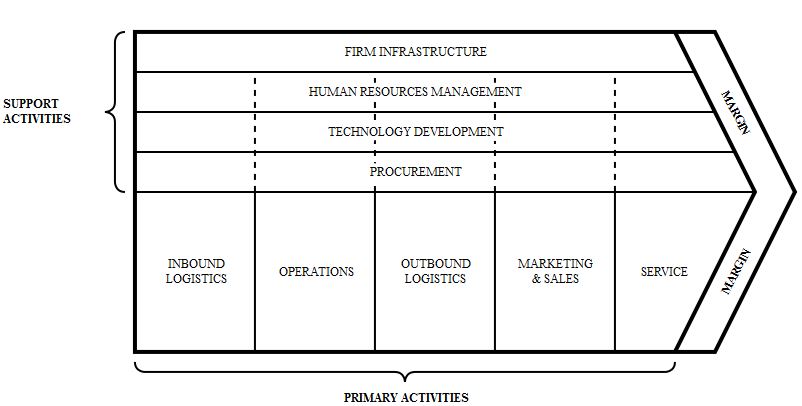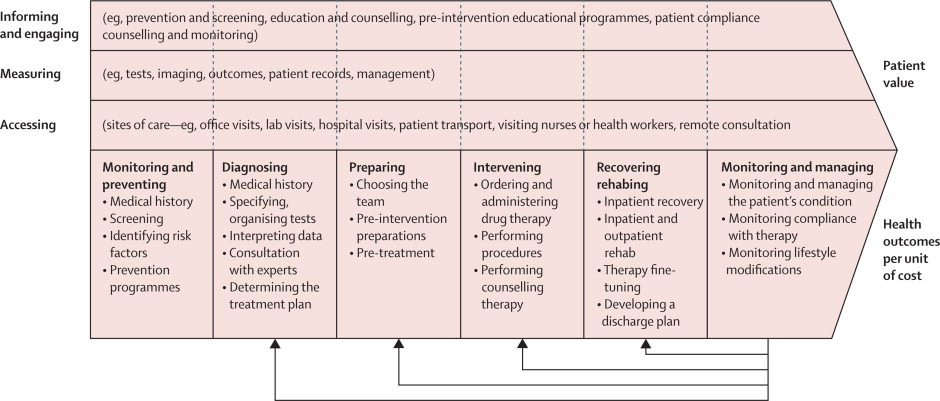 Value chain analysis is often applied to businesses. The approach takes the line of business or business unit as its focus–not the firm as a whole. And it looks at the overall industry, not just the slice of activities that a given organization undertakes. The idea is to understand how you go from, say, raw materials and their extraction or production to the finished product that is in the hands of the consumer.
Value chain analysis is often applied to businesses. The approach takes the line of business or business unit as its focus–not the firm as a whole. And it looks at the overall industry, not just the slice of activities that a given organization undertakes. The idea is to understand how you go from, say, raw materials and their extraction or production to the finished product that is in the hands of the consumer.
If you map the sets of activities entailed in delivering a product or service, you can use the analysis to understand how each activity contributes to the value that is delivered to the consumer by the end product or service. Businesses often seek to capture value generated by other parts of the value chain, or to redesign how they manage low-value-added components of the value chain. A key idea is that the value is the product of the entire chain–you need to look at the whole system. Here’s a basic overview of value chains from USAID. Note that while the focus on on health care, it’s taking a very general look at the productions of health services. If you’d like more detailed and practical guidance on product value chain mapping, this USAID site will keep you busy! We’ll be developing a different perspective of value chains in this note.
In social enterprise, several threads of work account for value chains. Consider its potential application in economic development presented in Upgrading along value chains: Strategies for poverty reduction in Latin America, a 2009 briefing paper by Jonathan Mitchell, Christopher Coles and Jodie Keane that examines how value chain analysis can help the rural poor participate gainfully in local, regional and global trade. Ashoka founder Bill Drayton and Valeria Budinich present their take on what they dub hybrid value chains in a September 2010 Harvard Business Review piece entitled “A New Alliance for Global Change” (find it at the MIT Library); here’s a quick overview of the hybrid value chain concept from the Ashoka site.
The Care Delivery Value Chain (or Prevention Delivery Value Chain)
In healthcare delivery, a different form of the value chain approach has proved useful for understanding how the various activities entailed in delivering care fit together. An organization can use value chain mapping to figure out how to improve quality (or lower costs) by delivering, or connecting patients to, the right services so that they benefit from the entire set of activities required for proper care. In class, for instance, we talked about how the value of testing is made much greater by connecting patients to treatment. Is this approach, the focus is the patient, not the creation and delivery of the product or service.
Care delivery value chain analysis is just one element in your toolkit–even if you sort out the potential value of connecting patients to treatment after they are tested, how to actually do that is a new set of challenges involving negotiation, implementation and execution, and many other practical steps.
To get you started in applying value chain analysis to healthcare, I lined up a few resources. First, for a broad introduction to the approach, look at Redefining Health Care: Creating Value-Based Competition on Results Michael E. Porter and Elizabeth Olmsted Teisberg (2005); you can purchase Appendix B, The Care Delivery Value Chain: Operationalizing Value-Based Health Care Delivery. A more conventional value chain approach is presented in the 2002 book, The Health Care Value Chain. Chapter One is online: it’s entitled The Wharton School Study of the Health Care Value Chain, by Lawton R. Burns, Robert A. DeGraaff, Patricia M. Danzon, John R. Kimberly, William L. Kissick, and Mark V. Pauly.
Once you’ve looked over this introduction, you may want to see some specific examples of value chains. I pulled some out from online materials:
In a September 2010 talk (Princeton Global Health Colloquium), Michael E. Porter drew on the approaches for a presentation on Value-Based Global Health Care Delivery (note the copyright notice on page 1). Check out the breast cancer example on slide 9, his outcomes hierarchy on slide 15, HIV/AIDS on slide 26, and prevention slide 28. Note that prevention is different from treatment! Acute knee osteoarthritis is mentioned in this more recent presentation (also by Porter) and chronic kidney care appears on page 11 of this slide deck. HIV/AIDS treatment is the focus of this 2009 Harvard Business School Working Paper, Applying the Care Delivery Value Chain: HIV/AIDS Care in Resource Poor Settings, by Joseph Rhatigan, Sachin Jain, Joia S. Mukherjee, and Michael E. Porter–which presents a detailed explanation of the delivery value chain.
If you would like to see even more examples, Samuel Bühlmann’s 2009 study of care delivery value chains for ophthalmic clinics in Switzerland presents several examples related to eye care, such as glaucoma care (see pages 22-26). Others applications include migraine care, examined in this online resource from the Advisory Board and this HBS case.
Clinical or care pathways
Within healthcare, some more clinically-grounded approaches may be worth contrasting with the value chain approach. While they are not designed to shed light on the strategic aspects of care delivery design, clinical or care pathways are finding much use in real-world clinical settings and are tools for quality improvement. Pathways depict the sequence of steps in care delivery by condition, based in clinical evidence and made practical by their grounding in practice. Here’s a brief introduction, and here’s more depth if you’d like to learn more. For those of you interested in a meta-analysis of their value in use, look at this Cochrane study of their effects on professional practice, patient outcomes, length of stay and hospital costs. Clinical pathways are intended to be normative: they tell clinical and other employees what steps to take in addressing a given condition. Implementation research (example) may be useful to consider if you would like to understand their value in use. To make this less abstract, check out some specific pathways designed to improve the quality of patient care. The site called “the map of medicine” presents several examples. Take a look at the map index. For example, here is a map of normal delivery.
Is the service delivery value chain a tool for innovation?
Does value chain mapping provide a method for uncovering potential innovations? It’s certainly useful in analyzing and accounting for potential sources of value in a healthcare system. Chapter 7 in Reimagining Global Health: An Introduction, edited by Paul Farmer, Arthur Kleinman, Jim Kim, and Matthew Basilico, makes the case; see pages 198 to 192 (here). And in a 2013 framework-setting paper in the Lancet, Kim, Farmer and Porter use it as a central idea in their call to redefine global health delivery (see pages 3, 4 and 5). But: how practical is the tool? Can it be used prospectively? What do you think?

